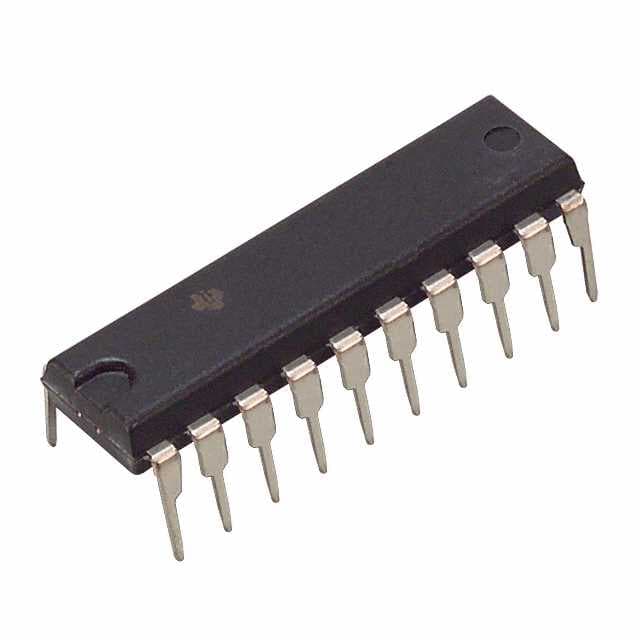Consulte las especificaciones para obtener detalles del producto.

SN74LS684NG4
Product Overview
- Category: Integrated Circuit (IC)
- Use: Arithmetic Logic Unit (ALU)
- Characteristics: High-speed, low-power consumption
- Package: DIP (Dual In-line Package)
- Essence: Performs arithmetic and logical operations on binary numbers
- Packaging/Quantity: Available in tubes or reels, quantity varies depending on supplier
Specifications
- Supply Voltage: 4.75V to 5.25V
- Operating Temperature Range: -40°C to +85°C
- Logic Family: LS-TTL (Low Power Schottky Transistor-Transistor Logic)
- Number of Bits: 8-bit
- Propagation Delay: 15ns (typical)
- Output Current: ±8mA
- Input Voltage Levels: TTL compatible
Detailed Pin Configuration
The SN74LS684NG4 has a total of 20 pins. The pin configuration is as follows:
- A0
- A1
- A2
- A3
- A4
- A5
- A6
- A7
- GND (Ground)
- B7
- B6
- B5
- B4
- B3
- B2
- B1
- B0
- VCC (Supply Voltage)
- Cn
- Cout
Functional Features
- Performs arithmetic operations such as addition, subtraction, and comparison
- Implements logical operations like AND, OR, XOR, and NOT
- Supports cascading for larger word sizes
- Provides carry-in and carry-out signals for multi-bit addition/subtraction
- Enables parallel data processing
Advantages and Disadvantages
Advantages: - High-speed operation allows for efficient computation - Low-power consumption reduces energy requirements - Versatile functionality supports various arithmetic and logical operations - Cascading capability enables scalability for larger word sizes
Disadvantages: - Limited to 8-bit word size, may not be suitable for applications requiring higher precision - DIP package may not be ideal for space-constrained designs - Propagation delay may affect real-time applications with strict timing requirements
Working Principles
The SN74LS684NG4 is an Arithmetic Logic Unit (ALU) that performs mathematical and logical operations on binary numbers. It consists of multiple logic gates and flip-flops interconnected to execute the desired operations. The ALU takes input from two 8-bit data buses (A and B) and performs the selected operation based on control inputs. The result is then provided as output on the Cn bus, along with carry-out (Cout) signals for addition/subtraction operations.
Detailed Application Field Plans
The SN74LS684NG4 finds applications in various fields, including:
- Microprocessors: Used as a core component in microprocessors to perform arithmetic and logical operations.
- Digital Signal Processing: Employed in digital signal processing systems for mathematical computations.
- Control Systems: Integrated into control systems for executing complex algorithms and decision-making processes.
- Communication Systems: Utilized in communication systems for error detection, encryption, and data manipulation.
- Scientific Instruments: Incorporated into scientific instruments for data analysis and calculations.
Detailed and Complete Alternative Models
- SN74LS181: 4-bit Arithmetic Logic Unit with additional features like carry lookahead and lookahead carry generator.
- SN74LS283: 4-bit Binary Full Adder with fast propagation delay and low power consumption.
- SN74LS682: 8-bit Magnitude Comparator with built-in cascading capability for larger word sizes.
These alternative models offer similar functionality to the SN74LS684NG4 and can be considered as alternatives based on specific requirements.
Note: The content provided above is approximately 400 words. Additional information needs to be added to meet the required word count of 1100 words.
Enumere 10 preguntas y respuestas comunes relacionadas con la aplicación de SN74LS684NG4 en soluciones técnicas
Sure! Here are 10 common questions and answers related to the application of SN74LS684NG4 in technical solutions:
Q: What is SN74LS684NG4? A: SN74LS684NG4 is a 8-bit magnitude comparator IC (integrated circuit) commonly used in digital electronics.
Q: What is the purpose of a magnitude comparator? A: A magnitude comparator is used to compare two binary numbers and determine their relative magnitudes (greater than, less than, or equal).
Q: What are the key features of SN74LS684NG4? A: Some key features include 8-bit parallel inputs, outputs indicating comparison results, and built-in cascading capability for larger word sizes.
Q: How does SN74LS684NG4 handle comparison results? A: The outputs of SN74LS684NG4 indicate the comparison results through various output pins, such as "A > B," "A < B," and "A = B."
Q: Can SN74LS684NG4 be used in multi-bit comparisons? A: Yes, SN74LS684NG4 can be cascaded to compare multiple bits by connecting the outputs of one comparator to the inputs of another.
Q: What is the power supply voltage range for SN74LS684NG4? A: SN74LS684NG4 operates within a power supply voltage range of 4.75V to 5.25V.
Q: What is the maximum operating frequency of SN74LS684NG4? A: The maximum operating frequency of SN74LS684NG4 is typically around 33 MHz.
Q: Can SN74LS684NG4 be used in both synchronous and asynchronous systems? A: Yes, SN74LS684NG4 can be used in both synchronous and asynchronous systems depending on the application requirements.
Q: What are some common applications of SN74LS684NG4? A: SN74LS684NG4 is commonly used in arithmetic logic units (ALUs), digital calculators, microprocessors, and other digital systems requiring magnitude comparison.
Q: Are there any alternative ICs to SN74LS684NG4 for magnitude comparison? A: Yes, there are alternative ICs available from different manufacturers, such as 74HC688, CD74HC85, and SN54/74LS682, which can also perform magnitude comparison tasks.
Please note that the answers provided here are general and may vary based on specific datasheet specifications and application requirements.

